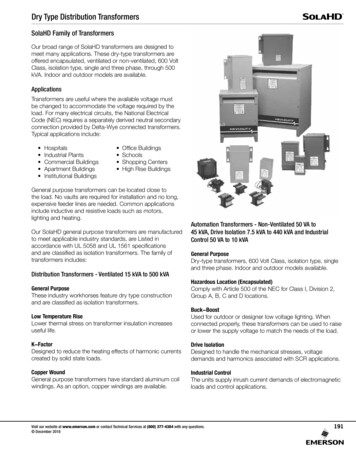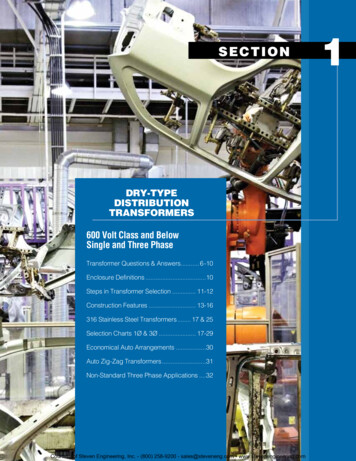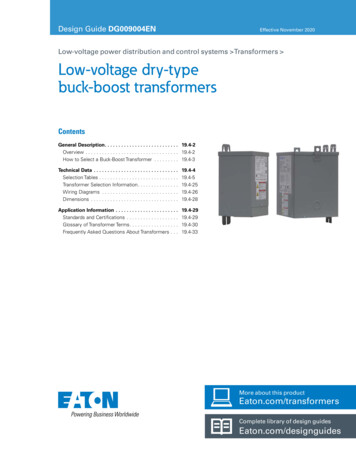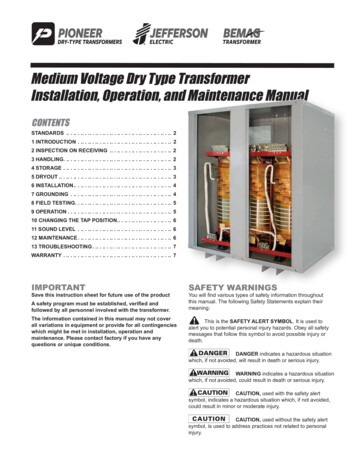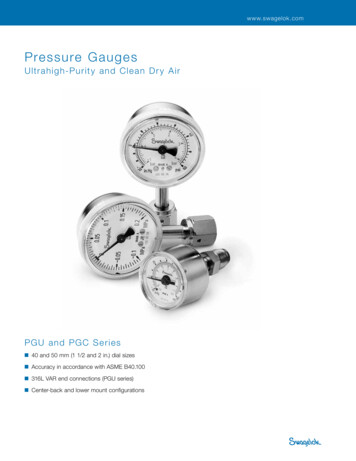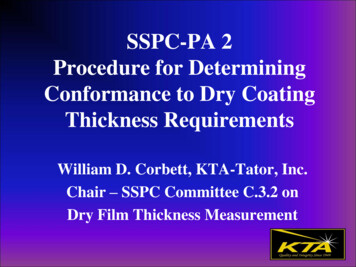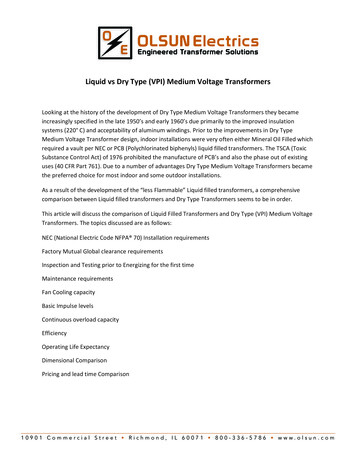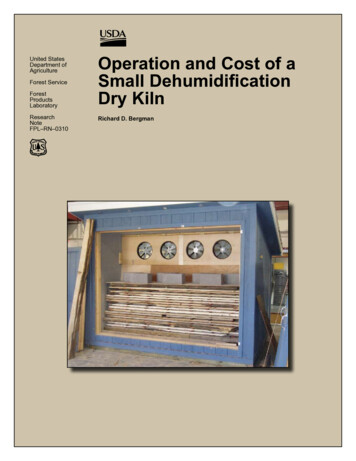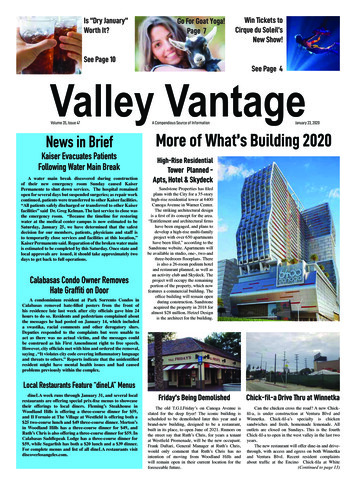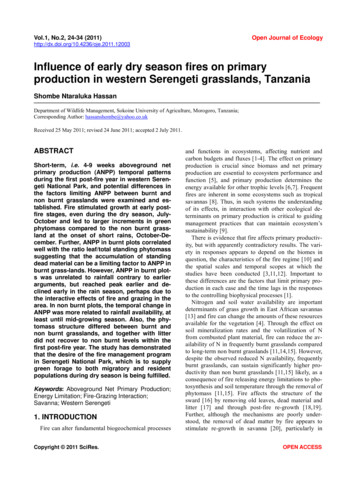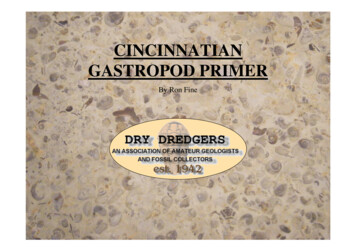
Transcription
CINCINNATIANGASTROPOD PRIMERBy Ron Fine
HOW DO SCIENTISTS CLASSIFY GASTROPODS?KINGDOM: Animalia PHYLUM: Mollusca oransScaphopodsAplacophorans PolyplacophoransCLASS: Gastropoda (Gastropods or Snails)Gastropods2
HOW MANY KINDS OF GASTROPODS ARE THERE?There are 611 Families of gastropods, but 202 are now extinctWhelkSlugLimpetConchLand SnailPeriwinkleCowrieSea ButterflyOyster BorerNudibranch3
THERE ARE 60,000 TO 80,000SPECIES!IN ENDLESS SHAPES ANDPATTERNS!4
HABITAT-WHERE DO GASTROPODS LIVE?GardensRiversRocky IntertidalZonesDesertsLakesWoodlandsOcean DepthsEstuariesSubtidal ZonesMountainsMud FlatsHydrothermal VentsDitchesTropical RainForestsSub-Arctic/Antarctic5
HABITAT-WHAT WAS IT LIKE IN THE ORDOVICIAN?Gastropods in the Ordovician of Cincinnati lived in atropical ocean, much like the Caribbean of today6
DIET-WHAT DO GASTROPODS EAT?HerbivoresDetritusParasitesPlant EatersMud EatersLiving on other animalsScavengersCiliaryCarnivoresEat dead animalsFilter feeding in the waterMeat Eaters7
ANATOMY-HOW DO YOU IDENTIFY A GASTROPOD?Gastropod is Greek, from “gaster” meaning ‘stomach’ and “poda” meaning ‘foot’They are characterized by a head with antennae, a large foot, coiled shell, a radula and operculumTorsion: all of a gastropod’s anatomy is twisted, not just the shellThey are the largest group of molluscs, only insects are more diverseMost are hermaphrodites8
GASTROPOD ANATOMY-FOOTGastropods have alarge “foot”, used forlocomotion.Undulating bands ofmuscles propel thegastropod forward, evenon vertical surfaces.SLIME! Gastropods excrete slime to helptheir foot glide over almost any surface.9
GASTROPOD ANATOMY-RADULAAll Molluscs, except for thebivalves, use a hard chitonoustoothy structure, the radula, forgathering food.Some predatory snails usetheir radula to bore holesthrough shells, then suck outthe soft parts. You can findtiny holes similar to this oneon many brachiopods in theCincinnatian.The cone snails have a dart-shaped radula,fired like a harpoon, for capturing prey.Most Gastropods areherbivores, using their radula toscrape algae and diatoms offthe surface of rocks, or eat thelettuce in your garden.10
GASTROPOD ANATOMY-ANTENNAMany gastropods, such as this Conch,have simple eyes on their antennae.Pomacea diffusa, the Spike ToppedApple Snail, has very long antennae.Gastropods have 2 or 4 antennae with sensoryorgans for feeling their way around, finding food, ordetecting danger.11
GASTROPOD ANATOMY-OPERCULUMMost gastropods have a calcareouscover, or plate, attached to their foot.Terrestrial and tidal zone gastropodsuse the operculum to seal their shell toprevent drying out when water isscarce.When a gastropod withdrawals into its shell, as this Whelk has done,the operculum covers the opening to protect it from predators.12
GASTROPOD ANATOMY-COILED SHELLThe most prominent feature of gastropods is thecoiled shell. Its found in nearly all gastropods,except Slugs and Nudibranches. Its also the onlypart of the gastropod preserved in the Cincinnatian.Some shells have a twist all theirown, Tenagodus anguina,Squamous Worm SnailPLANISPIRALCONISPIRALThe shell coils to one side,gradually tapering to a point.The shell coils in a singleplane, overlapping itself.13
NOT A GASTROPOD!Nautilus pompilius , Chambered NautilusNot all coiled shells belong togastropods. Many cephalopods,most now extinct, also possess them.Cephalopod shells have chambers.Gastropod shells do not.Ammonite with original shell material14
WHAT KIND OF GASTROPODS CAN YOU FIND IN THECINCINNATIAN?Gastropods can be found from the late Cambrian to the present day. The Cincinnatian,part of the Ordovician, has abundant varieties and quantities.15
CINCINNATIAN GASTROPODS-PRESERVATIONCyclonema-shell material preservedGastropodinternal moldGastropodinternal moldBivalveinternal moldMollusc shells are typically composed of a phosphatic substance called Aragonite.Unfortunately Aragonite does not preserve well in the Cincinnatian, so most gastropodfossils are internal molds. An exception is Cyclonema.16
CINCINNATIAN GASTROPODS-ABUNDANCEGastropods in the Cincinnatianare quite plentiful as loosefossils. But they also occur indense layers that run for miles.17
CINCINNATIAN GASTROPODSCyclonema is one of the fewCincinnatian gastropods thatpreserves as a shell instead of aninternal mold.Cyclonema humerosum (Ulrich) 1inchCyclonema bilix lata (Conrad) ¾ inchGrant Lake to Waynesville FormationsArnheim to Liberty FormationsCyclonema inflatum (Ulrich) ¾ inchFairview Formation18
CINCINNATIAN GASTROPODSLoxoplocus lophospira (Ulrich) 1 inchArnheim FormationLoxoplocus bowdeni (Safford) 2 inchesClathrospira conica (Hall) 1 ½ inchesGrant Lake to Drakes FormationsFairview to Whitewater Formations19
CINCINNATIAN GASTROPODSCyclora sp. Is the smallest Cincinnatian gastropod.Arnheim to Liberty FormationsTrochonema nitidium (Ulrich & Scofield) ½ inchSouthgate Member of Kope Formation20
CINCINNATIAN GASTROPODSHormotoma terebriformis (Foerste) 1 inchSubulites sulcata (Ulrich)Kope FormationKope FormationSubulites is one of the largest Cincinnatiangastropods, reaching 4 inches.21
CINCINNATIAN GASTROPODSLiospira vitruvia (Billings) 5/8 inchLiberty to Drakes Formations22
CINCINNATIAN MONOPLACOPHORANSSinuites cancellatus (Hall) ¾ inchSinuites granistriatus (Ulrich) 1 inchFairview to Whitewater FormationsKope FormationMonoplacophorans are actually a separate Class of Molluscs.But their identity is not settled, and they are often considered tobe primitive gastropods. They comprise all of the planispiralgastropods in the Cincinnatian.23
CINCINNATIAN MONOPLACOPHORANSPhragmolites dyeri (Hall) 3/8 inchTetranota bidorsata (Hall) 1 inchWaynesville to Liberty FormationsKope Formation24
CINCINNATIAN MONOPLACOPHORANSCyrtolites ornatus (Conrad) 1 ¼ inchesCyrtolites claysferryensis (Wuhlman) 3/8 inchKope to Whitewater FormationsKope FormationCyrtolites carinatus (Miller) ½ inchKope Formation25
CINCINNATIAN MONOPLACOPHORANSSalpingostoma richmondensis (Ulrich & Scofield) 2 ½ inchesLiberty to Whitewater Formations26
BIBLIOGRAPHYPAGE 1Gastropod Slab: Photo by Ron FinePAGE 2Cat ds Fish http://spelb.com/fish-wallpapers/Frogs a-rica/costa-rica-animalsScallop -season/Dragonfly htmlCephalopod ring-octopus/Gastropod ils-in-your-gardensBivalve http://www.geile-muscheln.de/arten.phpScaphopod mlAplacophoran http://eol.org/pages/57709/overviewPolyplacophoran http://biology.unm.edu/ccouncil/Biology 203/Summaries/Protostomes.htmMonoplacophoran nEIjCUktAClass Gastropoda tica%20sp.htmlPAGE 3Slug nce/ScienceKS3.phpLand Snail nt-african-land-snails-infesting-south-floridaPAGE 5Gardens .jpgWoodlands cient-woodlands/Deserts hotos-deserts-141280/Mountains raphy/Ditches http://www.dipity.com/tickr/Flickr ditch/Rivers http://rainforests.mongabay.com/0602.htmLakes s s/coastal research/estuary.htmlMudflats http://sunsetbeachandbirdislandnc.com/Sunset Beach Potpourri/Sunset Beach Potpourri.htmRocky Intertidal http://tbsecosystems.wikispaces.com/Rocky Intertidal ZoneSandy Subtidal http://www.aquaeolas.com/wp/Ocean Depths http://en.wikipedia.org/wiki/File:Coral Reef.jpgHydrothermal sum01/Hyrothremal%20Vent%20Final/hydrothermal vents.htmTropical Rainforest http://www.rainforestfauna.com/Near Arctic & 3%A1tt%C3%BArulj%C3%B3smyndun/interesting/PAGE 6Cincinnatian Habitat Fossils Of Ohio, Ohio Geological Survey, Bulletin 70, Columbus 1996PAGE 7Sea Butterfly tato-chip-of-the-sea/Herbivore Conch chChowder.htmCarnivore http://biologybiozine.com/Whelk stropods/Parasite et http://www.marietta.edu/ biol/biomes/rocky shores.htmDetritus /littFeed.phpPeriwinkle http://skimmer.disl.org/pastissues/vol15 no3 2004/periwinkle.htmScavengers http://www.andrewjmartinez.com/image.pl/392/ Northern Moon Snails scavenging a crab.htmlOyster Borer http://www.mesa.edu.au/AtoZ/Mulberry Oyster Borer.aspCiliary ails.htmlCowrie looking-orangecolored-creatures/Nudibranch udibranchs/PAGE 4Gastropods Arrayed: Photo by Ron FinePAGE 8Gastropod Diagram gastropods/GASTROPODA.htmPAGE 9Bottom Of Foot mlSnail On Anemone http://www.divegallery.com/tun.htmSnail on Leaf topic 11576.027
BIBLIOGRAPHYPAGE 10Radula http://www.pirx.com/gallery/mollusks/radulaScraped /Photo Insight with Heather Angel snail feeding trail features 310291.htmlDrilled Hole Defe.phpCone Snail Harpoon http://www2.fiu.edu/ PAGE 11PAGE 16Gastropod Preservation: Photo by Ron FinePAGE 17Gastropod Layer: Photo by Ron FineGastropod Rock: Photo by Ron FinePAGE 18Cyclonema Photos: Photo by Ron FinePAGE 19Conch Eyes m/snails-clams-nudibranchs/Loxoplocus Photos: Photo by Ron FineYellow Snail Antennae http://www.applesnail.net/Clathrospira: Photo by Ron FineOrange Snail Antennae E 12PAGE 20Trochonema: Photo by Ron FineWhelk Operculum ges/shellfish.htmlCyclora With Quarter: Photo by Ron FineOperculum ls.htmlCyclora Closeup: ra.htmlPAGE 13Pink Conch Conispiral ch-shell-the-way-to-a-woman%E2%80%99s-heart/Green & White Snail Conispiral tinction-at-a-snails-paceGreen River Snail Conispiral ngopaludina-japonica-river-snail.htmlIrregular Shell http://www.gastropods.com/7/Shell 1727.shtmlPlan View Planispiral http://en.wikipedia.org/wiki/Whorl (mollusc)White Shell Planispiral 5616943.htmlBrown Striped Shell Planispiral http://www.absoluteastronomy.com/topics/Marisa cornuarietisPAGE 14Nautilus s/Orange Ammonite http://chaoticutopia.com/friday-fractal-iCutaway Ammonite re fossil/Treasures/Ammonites/ammonite.html?aaPAGE 15Cincinnatian Hill Cut: Photo by Ron FinePAGE 21Subulites: Photo by Ron FineHormotoma: Photo by Ron FinePAGE 22Liospira: Photo by Ron FinePAGE 23Sinuites Photos: Photo by Ron FinePAGE 24Phragmolites: Photo by Ron FineTetranota: Photo by Ron FinePAGE 25Cyrtolites Photos: Photo by Ron FinePAGE 26Salpingostoma richmondensis (Ulrich & oda/Salpingostoma.html28
GASTROPOD ANATOMY-COILED SHELL 13 CONISPIRAL The shell coils to one side, gradually tapering to a point. PLANISPIRAL The shell coils in a single plane, overlapping itself.

